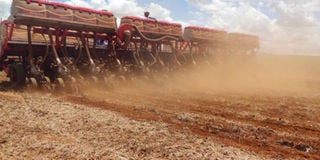Best farming practices Uganda can learn from Brazil

One of the maize farms in Brazil where no till technology is applied. Photo by Lominda Afedraru
Integrated agriculture
Practice: In Uganda, most small scale farmers practice mixed crop and livestock farming where they grow various types of crops and at the same time keep livestock on the same piece of land which may not lead to increased yields.
Lesson: However, Ugandan farmers could adopt a similar technology of mixed farming practiced by farmers in Brazil called integrated agriculture where a piece of land is utilised for planting forest trees and the same land is utilised for growing crops or keeping animals.
In Brazil, farm land used for integrated agriculture of livestock and forestry system and forestry cropping system is about nine million hectares.
No till technology
Practice: Another technology which some farmers in Uganda especially those growing banana are already practicing is the no till technology aimed at conservation of the soil nutrients for increased yields.
Lesson: No-till farming system which is practiced by a number of farmers in Brazil offers a way of optimising productivity and ecosystem services including soil conservation.
At the same time the technology enables agriculture to respond to some of the global challenges associated with climate change which include land and environmental degradation.
Expert take: Dr Lineu explained that the no till technology where the farm is covered with organic matter is for purposes of avoiding sunlight from penetrating through to the farmland that may cause weeds to grow.
Scientists at Embrampa developed a package of this technology where after grass is cut from the farm, it is left to rot into organic matter for a period of about one month and thereafter the farmer uses a planter to dig holes to plant the seeds.
Farmers are able to harvest increased yields because they apply fertiliser at the time of planting. The planter is used for both planting seed in one row and fertiliser in another row.
It is practiced by large scale farmers growing soybean, corn and bush beans and after harvesting the land is irrigated for replanting. Sometimes farmers use selective herbicide which clears the weed minus destroying the crops.
Dr Lineu says the advantage of this technology is that the soil is conserved and it retains nutrients which enables farmers to harvest increased yields.
The Director of Embrampa, Dr Ladisladous Martin Neto, explained that before the 1970s, Brazil did not have food security until new technologies were developed by scientists, including the use of modern biotechnology that led to boosting agricultural production in the country.
The country is now known as one of the largest producers of soybean and corn in the world.
This is possible because the scientists are breeding varieties which are resistant to pests and diseases, drought resistant and varieties that are fixing nitrogen to the soil especially soybean and breeding high quality animals.
Statistics indicates that about 214.8 million tonnes of grains, 43.8m tonnes of fruit, 26.8m tonnes of meat and 35m litres of milk were produced last year.
Since the country wanted to increase its food production, in 1995 it had to make sure that there was a biosafety law put in place to regulate adoption of GM crops.
Best practices
Dr Tumewsigye, commended the good work done by the scientists in Brazil and pledged the two countries to collaborate in issues related to science and technology.
He says it is possible for Ugandan farmers to adopt the no till technology and integrated farm practices as long as they plan for whatever piece of land they have.
Dr Tumewsigye says it is important to learn from scientists and other stakeholders involved in scientific innovations in Brazil and transform this knowledge for Uganda to move to a bio economy.
The chairperson of the Science and Technology committee, Eng Kafeero Sekitoleko explained that already the no till technology is being practiced in Uganda through minimum tillage using the hoe but there is a challenge of application of selective herbicides to clear weed because Uganda lacks this type of herbicide for farmer use.
Expert take
Dr Lineu Neiva Rodrigues from the Centre of Agriculture and livestock Research (Embrapa), explaining a number of farm practices to a team of legislators from Ugandan Parliament led by the Minister of Science, Technology and Innovations, Dr Elioda Tumwesigye, noted that some farmers plant trees and forage grass species which is integrated with cattle to feed on the forage while others integrate it with a particular crop.
The legislators went on a fact finding mission to understand how Brazil has been able to embrace farm production developed using modern biotechnology and to understand the legal framework governing release of such farm products.
Forestry and crop integration
The forestry and crop integration is done when the trees have not overgrown to maturity to allow sunlight for photosynthesis to take place.
The forestry and animal integration allows cattle to gain weight by 600 – 900 grammes per day because there is plenty of pasture in the forest cover for animals leading to better income earning.
Most farmers practicing this technology grow eucalyptus and many farmers who have adopted this technology do it on five hectares of land or more.
It is advantageous in that farmers are able to keep cash flow all the time and it helps in improving soil fertility and more productivity because cow dung will act as manure.
For farmers whose soils lack soil nutrient, especially those living in the Cerado region around the federal state Brazilia, scientists recommend that farmers ensure they use fertiliser boost the soil fertility.




